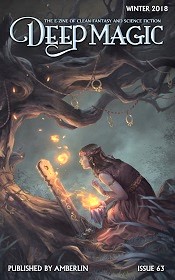“The Lady of Pain” by Steve DuBois
Reviewed by Victoria Silverwolf
Reviews of Deep Magic are new to Tangent, so a brief description of the publication is in order. Originally published from 2002 to 2006, it returned to life in 2016. After two years of bimonthly publication, it now appears as a quarterly ezine.
The masthead describes it as “the e-zine of clean fantasy and science fiction.” The editorial guidelines make it clear that the editors do not want stories with profanity or sexual themes. Although they also caution against graphic violence, some of the stories in this issue contain scenes of war and killing, and may not be suitable for very young readers.
The magazine pays for fiction at six cents a word. It will accept stories up to forty thousand words in length, but payment reaches a maximum at ten thousand words. The current issue contains two science fiction stories, three fantasies, and a sample chapter of a fantasy novel.
The narrator of “The Lady of Pain” by Steve DuBois has the magical power to heal injuries, but at a terrible cost. Both she and the person she heals experience all the pain the wound would have caused over time in a single moment, leading to nearly unbearable agony. She accompanies a party of mercenaries on a dangerous quest to obtain a valuable item from a deadly creature.
This story tests the limits of a family-friendly publication. There are brief, subtle references to sexual attraction between men and women, and between two men. Although without explicit gore, the plot involves frequent violence and suffering. One character is a sadist who enjoys killing. The quest is not a heroic one, but a gruesome, unpleasant task, undertaken only for profit. The author creates an exciting adventure, but one with a very dark tone. It almost reads like so-called grimdark fantasy.
In “Too Many Historians on the Western Front” by Paul R. Hardy, time travelers from the future visit the battlefields of the First World War. They interact with the soldiers, who think them odd, and sometimes annoying, but not miraculous. The reason for this is revealed in the story’s final twist. The theme is a clever one, and the contrast between the visitors and the soldiers is convincing. There is not much to the plot other than the basic idea. The reader may wish that the author had developed it further.
“Nix and Jack” by Maria J. Morillo is definitely an appropriate story for winter. Nix is the daughter of a sinister Snow Queen, but she does not have the same supernatural powers as her mother. For this reason, the Snow Queen kidnaps boys and holds them prisoner, waiting for one who can survive in her frozen realm and become her heir. All of them die, until Jack arrives. He learns to control ice magic, and the two fall in love. Together they plot to escape from the land of snow and defeat its evil ruler.
This is a romantic fantasy, which creates a vivid sense of cold. Brief scenes at the beginning and end, told from Jack’s point of view, offer a different mood, and seem out of place. The climactic battle between the heroes and the villainess is thrilling, but depends on unsuspected abilities of the daughter. Despite this deus ex machina, the story is an enjoyable one, best read by the fireplace with a mug of hot chocolate.
“Salvage” by Anthony Tardiff takes place in the asteroid belt of a distant star system, many thousands of years in the future. A miner discovers an escape pod from an ancient starship. Inside is the body of a woman, frozen in suspended animation. She might be dead. If not, it still might be impossible to revive her. As soon as they announce the discovery, the miner and his comrades receive an offer from an unknown source. If they destroy the pod, they will receive enough money to spend the rest of their lives in luxury. Their argument over the offer involves the miner’s hidden past, and a philosophical debate about whether the universe is completely random, or has a deeper meaning.
The story’s premise is suspenseful. The mining crew, the equivalent of blue-collar workers, is comprised of complex and believable characters. Although it’s clear which side of the debate the author supports, the opposing arguments are reasonable. One major problem is that the motive behind the offer is never explained. The escape pod is from an extremely distant time in the story’s past. It’s difficult to believe that anyone in this future would have a good reason for wanting it destroyed.
The title character of “The Poisoner’s Revenge – A Kingfountain Tale” by Jeff Wheeler is a woman believed to be dead by many of her enemies. She hides inside the castle of the king she serves. She uses magic and her knowledge of toxins in her role as a secret agent. When reports claim the queen of a rival nation is dead, the king sends her on a mission to uncover the truth. Plots and counterplots result, with a final conflict between the poisoner and an old foe.
This is an intricately plotted story, with multiple incidents of intrigue and deceit. An escape from prison is particularly clever. Some aspects of the woman’s magical powers are unclear. It seems likely that familiarity with her other adventures is necessary for full appreciation of this one.
Victoria Silverwolf broke one of the handles off her glasses today.
 Deep Magic
Deep Magic